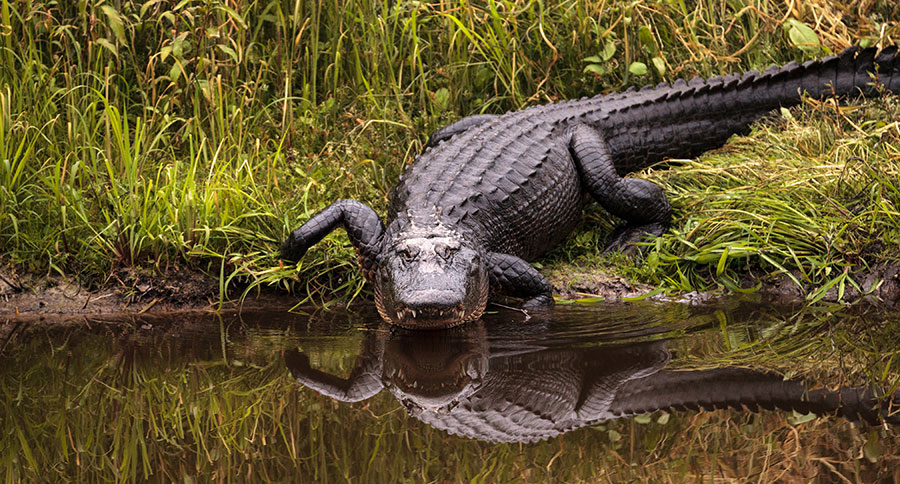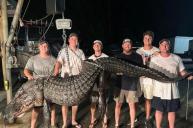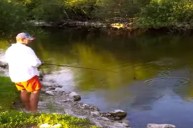The American alligator is a well known creature in North America. Here are all the details on the reptiles, including where to find them and what to do in an encounter.
The American alligator, or Alligator mississippiensis, might be one of the most well known animals in our country, but perhaps by name alone.
For those dwelling in the southern states such as Florida, Alabama, Louisiana, and Texas, these creatures are a part of modern day life, with populations in North Carolina and South Carolina as well.
Alligators can elicit several reactions in humans including fear, awe, respect, and utter terror. Gators have been a part of North America for 150 million years, largely based on the fact that they are a top level predator, and very successful at it. These large and powerful animals inhabit freshwater swamps, lakes, and even golf course ponds. Many would call them as sneaky as they are dangerous.
Big gators can swim fast, but did you know that they can run and even climb?
These large reptiles are carnivores of the highest order that can live to 30-50 years of age, reaching 10-15 feet long, and weighing in the order of 1,000 pounds. One look at these menacing predators, especially up close at their armored, reptilian bodies, massive muscular tails, and insanely powerful jaws, and it is obvious they are creatures from the distant past.
American Alligator Diet
Mature alligators feed mainly on large and small fish, snakes, small mammals, and are even capable of biting through a turtle's shell. However, they are opportunistic feeders, and a hungry gator will eat just about anything it can catch, including raccoons and other small mammals, pets, and in very rare instances, humans.
Since their teeth are not designed to chew but instead grip and rip, gators will grab their prey with powerful jaw muscles and take large gulps of food which they swallow whole. They are known to eat carrion, too.
Alligators sometimes leave the water to feed, ambushing prey from trails and even in backyard settings.
Hatchling alligators mostly feed on invertebrates such as insects, insect larvae, snails, spiders, and even crawfish. As they continue to grow, animals such as muskrats and unsuspecting water moccasins are on the menu.
American Alligator Distribution
Alligators are found mainly in the southeastern United States. According to Wikipedia, "American alligators are found in the wild from the Great Dismal Swamp in Virginia and North Carolina, south to Everglades National Park in Florida."
They are documented in parts of Virginia, North Carolina, South Carolina, Georgia, Florida, Louisiana, Alabama, Mississippi, Arkansas, Oklahoma, and Texas.
American Alligator Habitat
As stated, gators inhabit swamps, streams, rivers, ponds, and lakes, but will sometimes find an affinity for brackish water, though they do not tolerate saltwater very well. While there are small populations of American crocodiles in the U.S., they cannot survive water temperatures below 50 degrees like the alligator can.
Males tend to prefer open water during the spring and summer, while females seek swampier, shallow areas for cover and for nesting. In colder climate areas in the northern portion of their range, gators can survive by going into a period of dormancy, sticking their snout above the waterline to breath if the water freezes.
Breeding Season
The North Carolina Wildlife Resource Commission says, "Mating takes place in May through June. After mating, the female alligator begins to build a mound-like nest of leaves, sticks, mud and other debris. The nest, built near water, measures 2-3 feet tall and up to 6 feet in diameter. After approximately 65 days, the young hatch and are about 9 inches long."
Females and males band together in groups for courtship and to find mates. Males will begin to bellow by blowing the air out of their lungs, which can often be felt as much as heard.
After depositing 20-50 eggs in the nest, the female gator covers them again in vegetation to keep them warm. When the young alligators hatch, they begin to yelp for their mother, who in turn carries them to the water for safety.
The mother will guard her young ferociously, attacking anything she sees as a threat:
Alligators and Humans
According to the Florida Wildlife Commission, there have been 24 fatal alligator attacks since 1973. The Sunshine State has the largest population of gators at roughly 1.3 million.
It's important to remember to keep your distance from alligators in the first place. Never intentionally approach them or feed them.
Instances of attacks occur by accident, usually when a human invades the territory of a nesting female, or when the gator mistakes a human being for its normal prey. If in fact you do find yourself on the wrong end of an alligator attack, the first thing to do is to flee.
But let's say that the worst possible scenario happens, and you find yourself caught in the clutches of a gator, now what? Experts say without a doubt: fight back. Try to bash the reptile on its sensitive snout, and if that doesn't help, go straight for its eye sockets.
One resounding thing that you should never do is to try to pry the jaws open. And don't ever consider playing dead!
Alligators are an absolute load to handle even for those who have done it, and they don't give up easily.
The American Alligator's Future
The American alligator seems to be in little danger of disappearing anytime soon. Once considered threatened in the early part of the 20th century, alligator populations have been since listed as a least concern species, thanks to the Endangered Species Act.
This keystone species is also responsible for decreasing some of the invasive Burmese python numbers in Florida. As the National Geographic says, "The American alligator is a rare success story of an endangered animal not only saved from extinction but now thriving. State and federal protections, habitat preservation efforts, and reduced demand for alligator products have improved the species' wild population to more than one million and growing today."
Alligator Hunting
Currently, American alligators can legally be hunted in the states of Florida, Georgia, Alabama, Arkansas, Mississippi, Louisiana, North Carolina, South Carolina, and Texas.
The seasons vary depending on the state. Harvest numbers are determined with population sustainability firmly in mind, and both out of state and resident hunting opportunities are available in most places.
If an American alligator hunt was something you've always had on your list, make sure you realize how easy it can be. If you've got the resources and time, it's an amazing hunting experience everyone who's interested in it should be able to do.
Or, if hunting them isn't what you desire, just knowing a little more about these incredible creatures makes them all the more deserving of our respect.
After all, they've been here a lot longer than we have.
Looking for a little more or even hot lunch for your hunting blind? Follow my webpage, or on Facebook and Twitter.
NEXT: HOOKED MAKO SHARK LEAPS, NEARLY ENDS UP IN ANOTHER BOAT
WATCH




